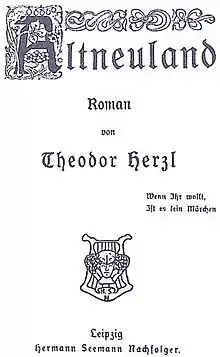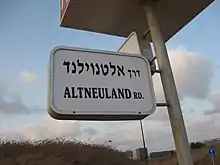The Old New Land
The Old New Land (German: Altneuland; Hebrew: תֵּל־אָבִיב Tel Aviv, "Tel of spring"; Yiddish: אַלטנײַלאַנד) is a utopian novel published by Theodor Herzl, the founder of political Zionism, in 1902. It was published six years after Herzl's political pamphlet, Der Judenstaat (The Jewish State) and expanded on Herzl's vision for a Jewish return to the Land of Israel, which helped Altneuland become one of Zionism's establishing texts. It was translated into Yiddish by Israel Isidor Elyashev (Altnailand. Warsaw, 1902),[1] and into Hebrew by Nahum Sokolow as Tel Aviv (also Warsaw, 1902),[2] a name then adopted for the newly founded city.
 First edition cover | |
| Author | Theodor Herzl |
|---|---|
| Original title | Altneuland |
| Translator | Lotta Levensohn (1997 edition) |
| Country | Austria-Hungary |
| Language | German |
| Genre | Utopian novel |
| Publisher | Seemann Nachf |
Publication date | 1902 |
| Media type | Print (hardback & paperback) |
| Pages | 343 |
| OCLC | 38767535 |
Plot introduction
The novel tells the story of Friedrich Löwenberg, a young Jewish Viennese intellectual, who, tired with European decadence, joins an Americanized Prussian aristocrat named Kingscourt as they retire to a remote Pacific island (it is specifically mentioned as being part of the Cook Islands, near Rarotonga) in 1902. Stopping in Jaffa on their way to the Pacific, they find Palestine a backward, destitute and sparsely populated land, as it appeared to Herzl on his visit in 1898.
Löwenberg and Kingscourt spend the following twenty years on the island, cut off from civilization. As they stop over in Palestine on their way back to Europe in 1923, they are astonished to discover a land drastically transformed. A Jewish organization officially named the "New Society" has since risen as European Jews have rediscovered and re-inhabited their Altneuland, reclaiming their own destiny in the Land of Israel. The country, whose leaders include some old acquaintances from Vienna, is now prosperous and well-populated, boasts a thriving cooperative industry based on state-of-the-art technology, and is home to a free, just, and cosmopolitan modern society. Arabs have full equal rights with Jews, with an Arab engineer among the New Society's leaders, and most merchants in the country are Armenians, Greeks, and members of other ethnic groups. The duo arrives at the time of a general election campaign, during which a fanatical rabbi establishes a political platform arguing that the country belongs exclusively to Jews and demands non-Jewish citizens be stripped of their voting rights, but is ultimately defeated.
Major themes
Herzl's novel depicts his blueprint for the realization of Jewish national emancipation, as put forward in his book Der Judenstaat (The Jewish State) published in 1896. Both ideological and utopian, it presents a model society which was to adopt a liberal and egalitarian social model, resembling a modern welfare society.[3] Herzl called his model "Mutualism" and it is based on a mixed economy, with public ownership of the land and natural resources, agricultural cooperatives, welfare, while at the same time encouraging private entrepreneurship. A true modernist, Herzl rejected the European class system, yet remained loyal to Europe's cultural heritage.
Rather than imagining the Jews in Altneuland speaking exclusively Hebrew, the society is multi-lingual – with German, Hebrew and Yiddish being the main languages and reproducing European customs, going to the opera and enjoying the theatre. While Jerusalem is the capital, with the seat of parliament ("Congress") and the Jewish Academy, the country's industrial center is the modern city of Haifa. In the actual Israel, this role was to be taken by Tel Aviv, a city which did not yet exist at the time of writing and whose name was inspired by the book itself (see below).
Herzl saw the potential of Haifa Bay for constructing a modern deep-water port. However, in reality it would be the British Empire rather than the Zionists which would realise that potential and make considerable strategic use of it during the Second World War. Though Israel would eventually inherit the Haifa port and city, by 1948 the central role of Tel Aviv was established, with Haifa – though a major Israeli city – relegated to a secondary position.
As envisioned by Herzl, "All the way from Acco to Mount Carmel stretched what seemed to be one great park". In the actual Israel the very same area became a giant industrial zone, reckoned the most heavily polluted part of the country.
Herzl's depiction of Jerusalem includes a rebuilt Jerusalem Temple. However, in his view, the Temple did not need to be built on the precise site where the old Temple stood and which is now taken up by the Muslim Al-Aqsa Mosque and Dome of the Rock - very sensitive holy sites. By locating the Temple at a different Jerusalem location, the Jewish state envisioned by Herzl avoids the extreme tension over this issue experienced in the actual Israel. Also, worship at the Temple envisioned by Herzl does not involve animal sacrifice, which was the main form of worship at the ancient Jerusalem Temple. Rather, the Temple depicted in Alteneuland is essentially just an especially big and ornate synagogue, holding the same kind of services as any other synagogue.
In sharp contrast to the actual Israel, the country envisioned in Herzl's book is not involved in any wars and in fact does not maintain any armed forces. As explained in the book, the founders took care to get the consent of all European powers for their enterprise and not get entangled in any inter-power rivalry. As for the country's Arab inhabitants, the book's single Arab character, Rashid Bey, explains that the Arabs saw no reason to oppose the influx of Jews, who "developed the country and raised everybody's standard of living". Though at the time of writing there had already been some small-scale incidents between early Zionist pioneers and Arab villagers, these were usually explained away as "banditry" rather than organized Arab resistance to Zionism, and the future predicted in Herzl's book was still plausible.
As noted in a lengthy flashback detailing, a Zionist Charter Company named "The New Society for the Colonization of Palestine" was able to get "autonomous rights to the regions which it was to colonize" in return for paying the Turkish Government two million pounds sterling in cash, plus fifty thousand pounds a year and one fourth of its net annual profits. In theory, "The ultimate sovereignty" remained "reserved to the Sultan"; in practice, however, the entire detailed description given in the book does not mention even the slightest vestige of an Ottoman administration or of any Ottoman influence in the life of the country.
The territorial extent of the envisioned Old New Land is clearly far greater than that of the actual Israel, even including its 1967 conquests. Tyre and Sidon in the present Lebanon are among its port cities. Kuneitra - actually at the extreme end of the Golan Heights which Israel captured in 1967, and handed back to Syria in 1973 - was in Herzl's vision a prosperous way station on a railway extending much further eastwards, evidently controlled by "The New Society". In another reference are mentioned "the cities along the railway to the Euphrates - Damascus and Tadmor" (the latter a rebuilt Palmyra). Assuming all that to be under control of "The New Society", it would imply its territory as embracing virtually the whole of the actual Syria.
Having obtained the general concession from the Ottoman government, "The New Society" set out to buy up the land from its private owners. As depicted in the book, the sum of 2,000,000 pounds was set aside to pay the land owners. A single agent traveled the land and within a few months secured to "The New Society" ownership of virtually its entire land area, evidently encountering no opposition and no unwillingness to sell,
In all of that, Herzl's vision turned out to be manifestly unrealistic. The Ottomans proved completely unwilling to concede any part of their Empire to the Zionist Movement, and the sale of individual Arab plots of land proved one of the most contentious issues of what would become the Israeli-Palestinian Conflict. Until 1947, the Zionist movement would be able to buy up less than 7% of the land of Palestine; in 1948 it would obtain much more, a result of that year's UN partition plan and subsequent military conquest.
Legacy

The book was immediately translated into Hebrew by Nahum Sokolow, who gave it the poetic title "Tel Aviv", using tel ('ancient mound') for 'old' and aviv ('spring') for 'new'.[4] The name as such appears in the Book of Ezekiel, where it is used for a place in Babylonia to which the Israelites had been exiled (Ezekiel 3:15). The Hebrew title of the book was chosen as the name for a new neighbourhood of Jaffa, established in 1909 under the uninspired name of "Ahuzat Bayit", lit. "Homestead". The new name, Tel Aviv, replaced the original one only a year later, in 1910, and was used for the expanded settlement, now comprising two more adjacent neighbourhoods. Eventually Tel Aviv would become known as "the first [modern] Hebrew city" and a central economic and cultural hub of Israel.
Herzl's friend Felix Salten visited Palestine in 1924 and saw how Herzl's dream was coming true. Next year, Salten gave his travel book the title Neue Menschen auf alter Erde (“New People on Old Soil”),[5] and both the title of this book and its contents allude to Herzl's Altneuland.[6]
Publication details
- 1902, Germany, Hermann Seemann Nachfolger, Leipzig, hardback (First edition) (as Altneuland in German).
- 1941, US, Bloch Publishing, April, 1941, hardback (translated ... by Lotta Levensohn).
- 1961, Israel, Haifa Publishing, 1961, paperback (as Altneuland in German).
- 1987, US, Random House (ISBN 0-910129-61-4), 1987, paperback.
- 1997, US, Wiener (Markus) Publishing (ISBN 1-55876-160-8), 1997, paperback.
References
- "Altneuland" - First Yiddish Edition - Warsaw, 1902. Kedem Auction House, 2018
- "Tel Aviv" - First Hebrew Translation of Theodor Herzl's "Altneuland". Kedem Auctions,2016
- This Day in Jewish History 1902: Theodor Herzl Finishes His Novel 'Old-New Land'
- Shlomo Avineri, Zionism According to Theodor Herzl, in Haaretz (20.12.2002). Quote: "Altneuland" is [...] a utopian novel written by [...] Theodor Herzl, in 1902; [...] The year it was published, the novel was translated into Hebrew by Nahum Sokolow, who gave it the poetic name "Tel Aviv" (which combines the archaeological term "tel" and the word for the season of spring).
- Salten, Felix (1925). Neue Menschen auf alter Erde: Eine Palästinafahrt (in German). Wien: Paul Zsolnay Verlag. LCCN 25023844.
- Eddy, Beverley Driver (2010). Felix Salten: Man of Many Faces. Riverside (Ca.): Ariadne Press. p. 355. ISBN 978-1-57241-169-2.
External links
- Altneuland by Theodor Herzl, English translation at the Wayback Machine (archived December 6, 2008)
- Full text translation at Jewish Virtual Library
- Dreaming of Altneuland. The Economist, December 21, 2000.
- The Herzl Museum in Jerusalem